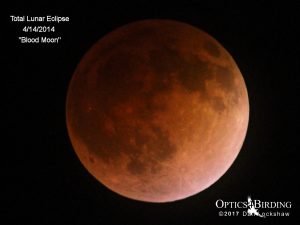
The moon becomes very reddish in color as the total eclipse progresses. Light refracted from our atmosphere dimly lights the “blood moon”.
The first of four total eclipses of the moon was visible late in the evening of April 14, 2014. A blood moon is another name for a total lunar eclipse. The refracted light as it passes through our atmosphere is the only light that hits the moon. In essence, this has the effect of casting a red sunset onto the moon. Going forward, one of the remaining three total eclipses of the moon will occur each 6 months. This frequency of total eclipses has not occurred in over three hundred years. This is a pleasurable and easy event to enjoy with binoculars.
The events are also unique for multiple other reasons. The first reason is because all four eclipses will be visible from somewhere in North America. This first eclipse had the added attraction of also being on the same night as the closest approach of Mars to the earth since 2008. Just below the red planet was the blood moon. A celestial event that will not happen again in our lifetimes.
Watching and Photographing the blood moon
Having a telescope made the event special although it was clearly visible with the naked eye (or good spotting scope / binoculars from Optics4Birding!). From my home I took the video below. Notice the orientation of the moon. It is the same as you see as you look at it with you eyes. Looking through an astronomical telescope the image flipped or rotated. This is a unique advantage of spotting scopes in both photography and viewing. These photos were shot using an 85mm Swarovski ATX Spotting Scope and Canon 7D camera with the appropriate digiscoping adapters. A very simple and quality setup that we have showcased in other posts here on our blog.

